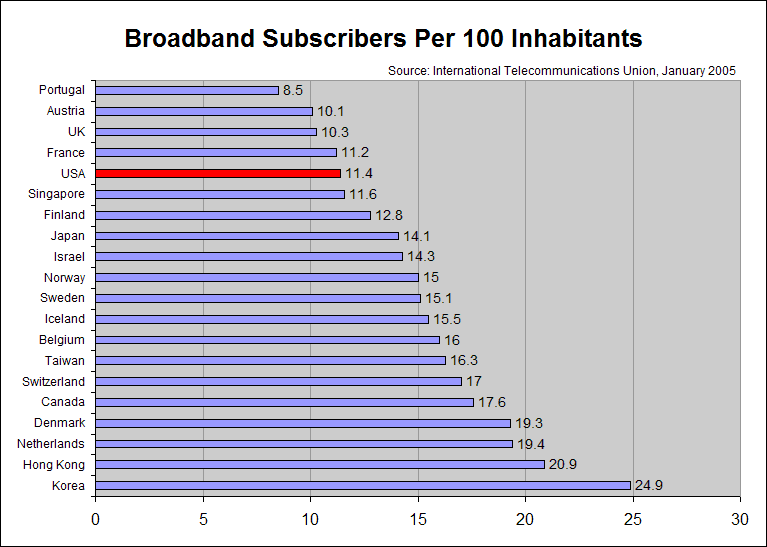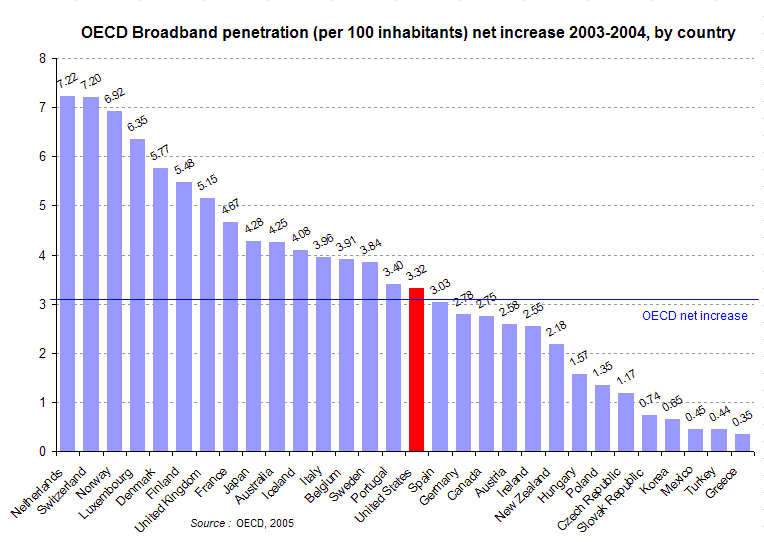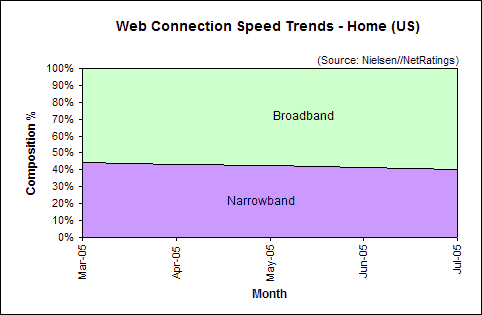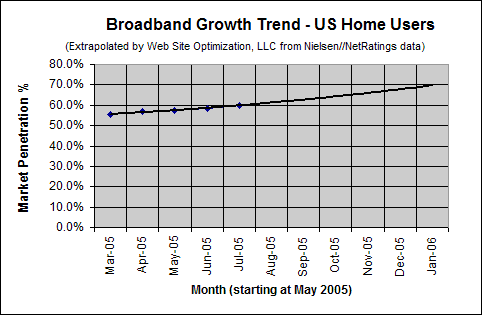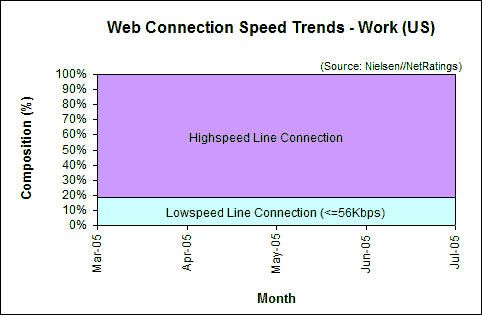The Free Press, Consumers Union, and the Consumer Federation of America respond to the July FCC report with a report titled “Broadband Reality Check” claiming that the US government is stifling broadband competition in favor of the DSL/Cable duopoly. Meanwhile, the US has dropped from 13th to 16th worldwide in broadband penetration. In July, US broadband penetration jumped 1.35 percentage points to 59.92% among active Internet users. By August, US broadband penetration should break 60%.
The charts below, derived from Nielsen//NetRatings, ITU, and OECD data, show trends in connection speeds to the Internet for users in the United States and other countries.*
FCC Ignores Digital Divide While US Broadband Drops Worldwide
In response to the July FCC report cited last month the Free Press, Consumers Union, and the Consumer Federation of America make a compelling case that US government policy is fostering the digital divide in the US in their report Broadband Reality Check: The FCC ignores America’s Digital Divide (PDF, 763K). Despite FCC Chairman’s Kevin Martin’s statement in the Wall Street Journal (July 27, 2005) that the United States “leads the world in total number of broadband connections” and “broadband platforms are engaged in fierce competition” on a per-capita basis the US has dropped from 13th to 16th among nations globally in broadband penetration with 11.4 connections per 100 inhabitants (see Figure 1). This drop follows last year’s fall from 11th to 13th. The report concludes that the US is falling behind in broadband speeds due to market and policy failures.
Global Broadband Penetration per 100 Inhabitants
The Netherlands to pass Korea in Broadband Penetration
While Korea leads all nations in broadband penetration (24.9 subscribers per 100 inhabitants, see Figure 1), the Netherlands is poised to surpass Korea by the end of 2005 in broadband penetration. The Netherlands, Switzerland, and Norway lead all OECD countries in broadband growth rates (see Figure 2).
Broadband Penetration net increase 2003-2004 by country
Figure 2: OECD Broadband Penetration per 100 Inhabitants net increase 2003-2004 by country – Source: OECD.org, December 2004 (updated July 29, 2005)
Home Connectivity in the US
Most active Internet users connect from home with broadband connections. In the US, Narrowband users (56Kbps or less) comprise 40.08% of active Internet users, down 1.35 percentage points from 41.43% in June 2005 (see Figure 3).
Web Connection Speed Trends – Home Users (US)
Figure 3: Web Connection Speed Trends – Home Users (US)
Source: Nielsen//NetRatings
Broadband Growth Trends in the US
Broadband penetration in the US grew by 1.35 percentage points to 59.92% in July, up from 58.57% in June. This increase is above the average increase in broadband of 1.14 points per month over the last five months. At the current growth rate of over 1.1 percentage points per month, broadband penetration among active Internet users in the US should break 60% by August 2005, and 70% by January of 2006 (see Figure 4).
Broadband Connection Speed Trend – Home Users (US)
Figure 4: Broadband Connection Speed Trend – Home Users (US)
Extrapolated from Nielsen//NetRatings data
Work Connectivity
Most workers in the US enjoy high-speed connections to the Internet. Most use a high-speed line such as a T1 connection, and share bandwidth between computers connected to an Ethernet network. The speed of each connection decreases as more employees hook up to the LAN. As of July of 2005, of those connected to the Internet, 81.64% of US users at work enjoy a high-speed connection, up 0.09 percentage points from the 81.55% share in June. At work, 18.36% connect at 56Kbps or less (see Figure 5).
Web Connection Speed Trends – Work Users (US)
Figure 5: Web Connection Speed Trends – Work Users (US)
Source: Nielsen//NetRatings
Overall US Broadband Penetration
Using data from the FCC and the US Census, the overall broadband penetration rate in the US is 28.7%. This was calculated by dividing the total number of lines in residential and small business subscribers by the number of US Postal Service addresses. So the overall broadband penetration rate in the US is 35.26 million divided by 122.8 million which equals 28.7%. You can see that the overall broadband penetration rate is about half of the broadband penetration rate for Internet users (the figure we report above). This ratio is similar to what we’ve seen in other countries.
Further Reading
- Belgium Leads European Countries in Broadband Penetration
- Belgium, the Netherlands, and Switzerland lead European countries in overall broadband penetration, according to a survey by HeavyReading.com in March 2005. These countries show a similar pattern that the US exhibits of having about half the overall broadband penetration rate as broadband penetration reported for Internet users alone.
- Broadband Reality Check: The FCC ignores America’s Digital Divide (PDF, 763K)
- A response to the July FCC report cited below by the Free Press, Consumers Union, and Consumer Federation of America. By S. Derek Turner, Free Press, August 2005.
- Down to the Wire
- “Once a leader in Internet innovation, the United States has fallen far behind Japan and other Asian states in deploying broadband and the latest mobile-phone technology. This lag will cost it dearly.” By Thomas Bleha, ForeignAffairs.com, May/June 2005.
- FCC Fudging Broadband Figures?
- Critics wonder if the FCC is slanting the numbers in its latest broadband survey. One subscriber per ZIP code, a 200 Kbps standard of “high-speed” (Canada’s is 1.5 Mbps), high cost (10 to 25 times the cost of broadband in Japan), lack of real competition and increase in broadband speeds has critics wondering about the FCC figures.
- High-Speed Services for Internet Access: Status as of December 31, 2004
- Federal Communications Commission, July 2005.
- Nielsen//NetRatings
- Provides the US broadband data (percentage of active Internet users) for the Bandwidth Report.
- OECD Broadband Statistics, December 2004
- Globally, broadband subscriptions increased 41% in 2004. At its current growth rate, the Netherlands could surpass Korea in broadband penetration by the end of 2005.
- US Census
- Provides population data for the United States.
*Note that Nielsen//NetRatings new NetSpeed report differs from the previous Web connection data in two ways. First NetSpeed determines the connection speeds of the Digital Media Universe, which combines Web traffic, Internet applications and proprietary channels. The old Web connection data was based solely on Web traffic. The other difference is that the old Web connection data was based on panelists where the linespeeds are known. Since linespeeds don’t change often, if a panelists has an unknown linespeed, their previous month’s speed is taken.
The Bandwidth Report is featured monthly on URLwire – news of useful and unique web content since 1994.

